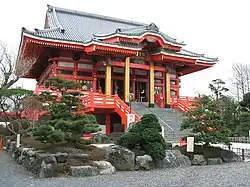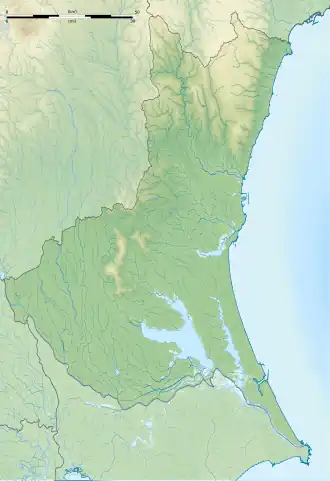Enpuku-ji
| Enpuku-ji | |
|---|---|
円福寺 | |
 Kannon-do (Hondo) | |
| Religion | |
| Affiliation | Buddhist |
| Deity | Jūichimen Kannon Bosatsu |
| Rite | Shingon Buddhism |
| Status | functional |
| Location | |
| Location | 293Baba, Chōshi-shi, Ibaraki-ken |
| Country | |
 Shown within Ibaraki Prefecture  Enpuku-ji (Japan) | |
| Geographic coordinates | 35°43′55″N 140°50′26.2″E / 35.73194°N 140.840611°E |
| Architecture | |
| Founder | c.Kūkai |
| Completed | c.Kōnin era (810-824) |
Enpuku-ji (円福寺) is a Buddhist temple located in the Baba neighborhood of the city of Chōshi, Chiba Prefecture, Japan. It is an independent temple under Shingon Buddhism and its honzon is a statue of Jūichimen Kannon Bosatsu, also popularly known as the Iinuma Kannon (飯沼観音). The temples full name is Iinuma-zan Enpuku-ji (飯沼山円福寺). The temple is the 27th stop on the Bandō Sanjūsankasho pilgrimage route. [1]
Overview
The origins of this temple are uncertain. According to the temple's legend, two fishermen scooped up a statue of the Jūichimen Kannon in their nets in the first year of the Jinki era (724) and became monks. During the Tenpyō era (729-749) the wandering priest Gyōki heard this story and made an altar. However, when it was completed, the altar was a little too small, so the statue bowed its head and entered the altar by itself. Later, Kūkai, who visited this area during the Kōnin era (810-824), constructed a temple.[2] After the Kamakura period, the temple flourished as a result of the devotion of the local Kaijō clan who ruled this area. In 1591, Tokugawa Ieyasu gave the temple a red seal and the various halls were maintained. The Kannon-do was built in 1578, but extensively renovated in 1773, and other buildings, such as a Niōmon and Tahōtō were constructed. Most of the temple was destroyed in 1945 in the Chōshi air raids, and its current structures are all post-war reconstructions. [3]
The five-story pagoda at the temple was completed in 2009 and is 33.55 meters tall.
The temple is a five-minute walk from Kannon Station on the Choshi Electric Railway Line.
-
 Sanmon
Sanmon -
.jpg) Pagoda
Pagoda -
 Daishi-do
Daishi-do -
Precincts
Cultural Properties
National Important Cultural Properties
- Nyō (鐃), an early Heian period cast-bronze gong used for Buddhist rituals. Currently housed at the Nara National Museum. Designated a National Important Cultural Property. [4]
Chiba Prefectural Important Cultural Properties
- Temple bell (梵鐘, bonshō) carrying the nengō "Kyōtoku 11" (i.e., the 11th year of the Kyōtoku period, 1462) [5]
- Shaka Nehan-zu (釈迦涅槃図), Edo Period (1663); a 354.6 cm x width Buddhist scroll in three parts[6]
References
- ^ Yuichi Kobayashi (2020). 坂東三十三ヶ所札所めぐり 観音霊場巡礼ルートガイド. Meitsu shuppan. ISBN 4780426049.
- ^ Fukuda, Yūsen (1935), "Bōsō ni odoru hitobito (房總の概觀)", Bōsō ni odoru hitobito (房總に躍る人々) (in Japanese), Chiba: Bōsō Jidaisha Shuppanbu, p. 7, OCLC 672553619
- ^ Official home page(in Japanese)
- ^ "鐃" (in Japanese). [Chiba Prefectural Board of Education. Retrieved August 20, 2020.
- ^ "梵鐘(享徳十一年在銘)" (in Japanese). [Chiba Prefectural Board of Education. Retrieved August 20, 2020.
- ^ "梵釈迦涅槃図" (in Japanese). [Chiba Prefectural Board of Education. Retrieved August 20, 2020.
- "Enpuku-ji". Nihon Rekishi Chimei Taikei (日本歴史地名大系 “Compendium of Japanese Historical Place Names”). Tokyo: Netto Adobansusha. 2010. Archived from the original on 2007-08-25. Retrieved 2010-07-15.
- Chiba-ken Kōtō Gakkō Kyōiku Kenkyūkai. Rekishi Bukai. (1989). Chiba-ken no rekishi sanpo (千葉県の歴史散步 "A Walk of Chiba Prefecture's History"). Tokyo: Yamakawa Shuppansha. ISBN 978-4-634-29120-1.
External links
![]() Media related to Enpuku-ji (Chōshi) at Wikimedia Commons
Media related to Enpuku-ji (Chōshi) at Wikimedia Commons
- Official home page(in Japanese)
- Bando Pilgrimage official site(in Japanese)